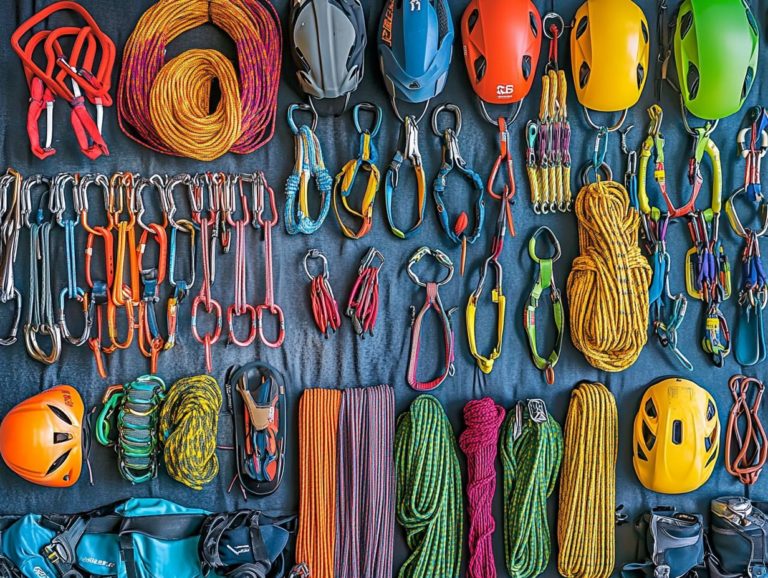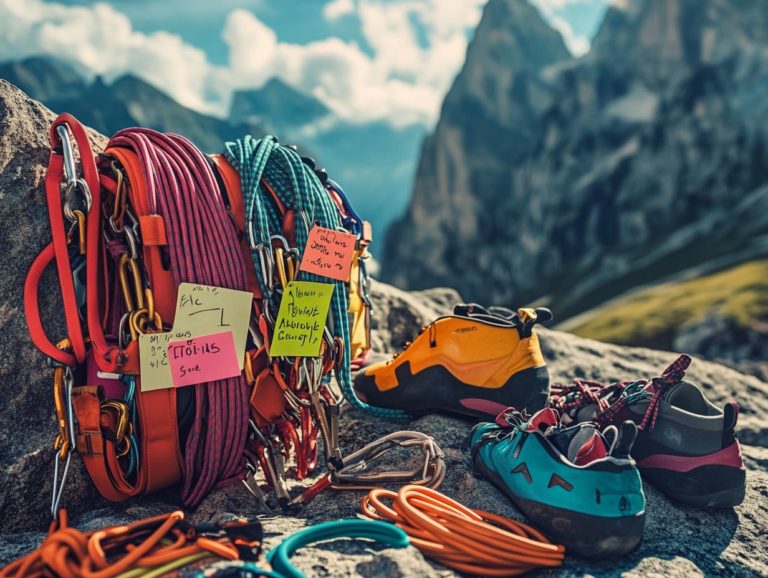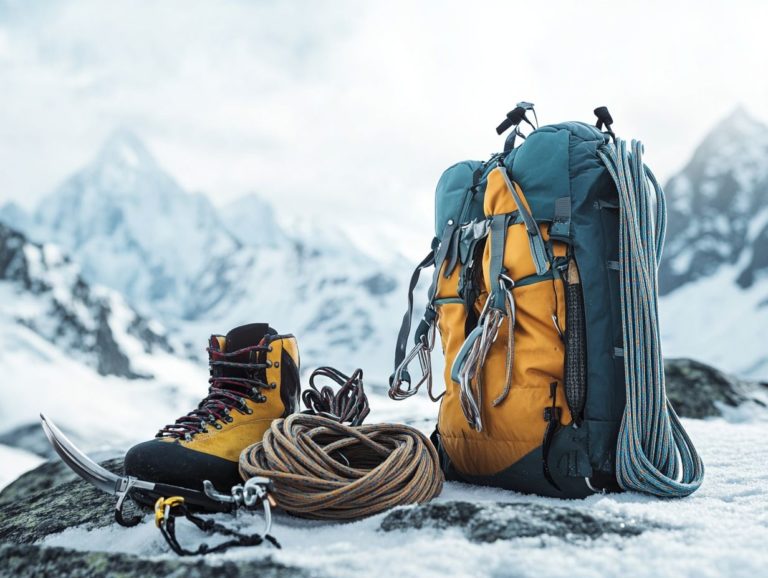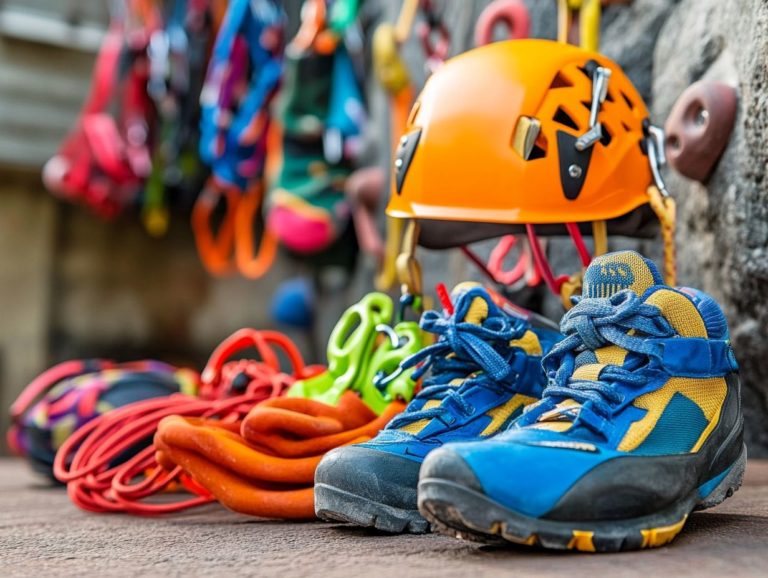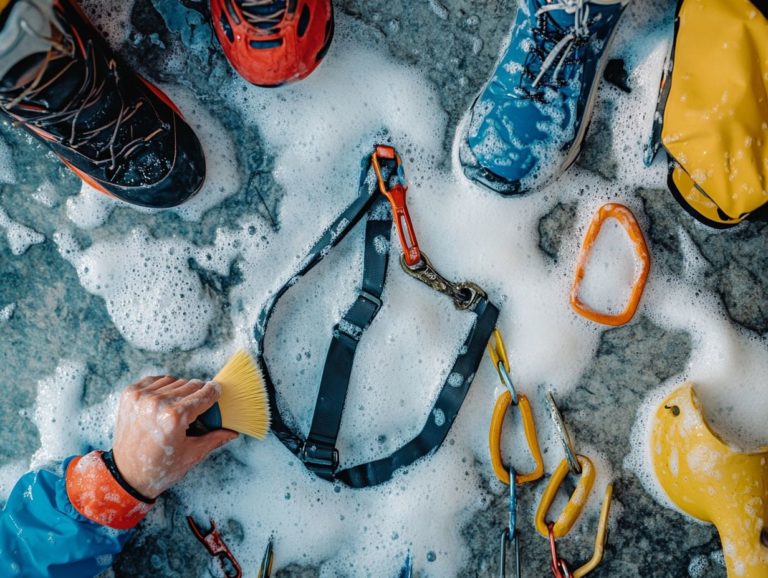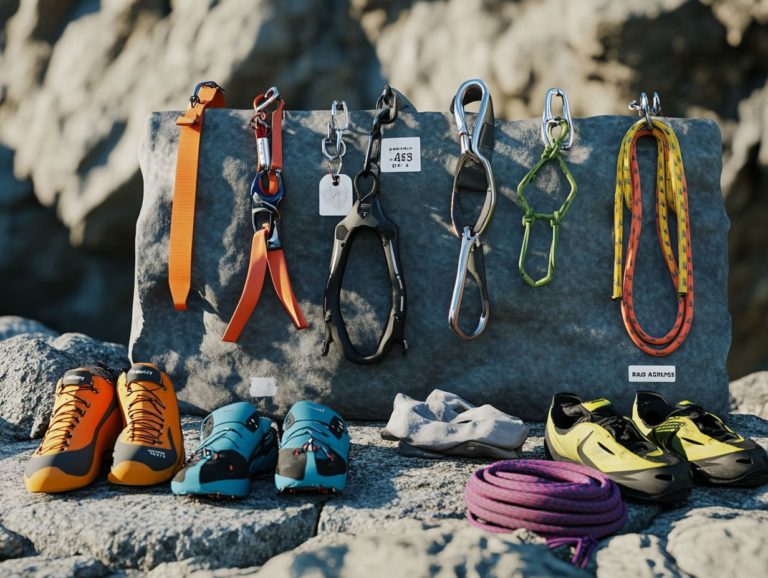Best Climbing Gear for Extreme Conditions
Get ready for your next big adventure! With the right gear, you can conquer Denali in Alaska. When facing extreme climbing conditions, having the right gear can truly be the difference between a triumphant ascent and a perilous ordeal.
This guide outlines the essential climbing gear you ll need, from climbing shoes and harnesses to ropes and specialized tools like crampons and ice axes, ensuring your comfort and performance in a variety of weather conditions.
Whether you re a seasoned climber or just embarking on your journey, knowing how to select the right gear specifically for harsh environments will boost both your safety and performance, protecting your extremities against extreme-cold conditions.
Explore the must-have items for your next adventure, from insulated socks to overboots that provide warmth on those icy trails!
Contents
- Key Takeaways:
- 1. Climbing Shoes
- 2. Harness
- 3. Ropes
- 4. Carabiners
- 5. Crampons
- 6. Ice Axe
- 7. Helmet
- 8. Climbing Gloves
- 9. Belay Device
- 10. Quickdraws
- 11. Chalk Bag
- 12. Climbing Pack
- 13. Headlamp
- 14. First Aid Kit
- 15. Navigation Tools
- How to Choose the Right Climbing Gear for Extreme Conditions?
- Frequently Asked Questions
- What are the essential items for extreme climbing conditions?
- Which brand offers the best climbing gear for extreme conditions?
- What type of ropes should I use for extreme climbing?
- Do I need specialized clothing for extreme climbing?
- What should I look for in a climbing helmet for extreme conditions?
- Are there any specific features to consider when choosing ice axes for extreme conditions?
Key Takeaways:
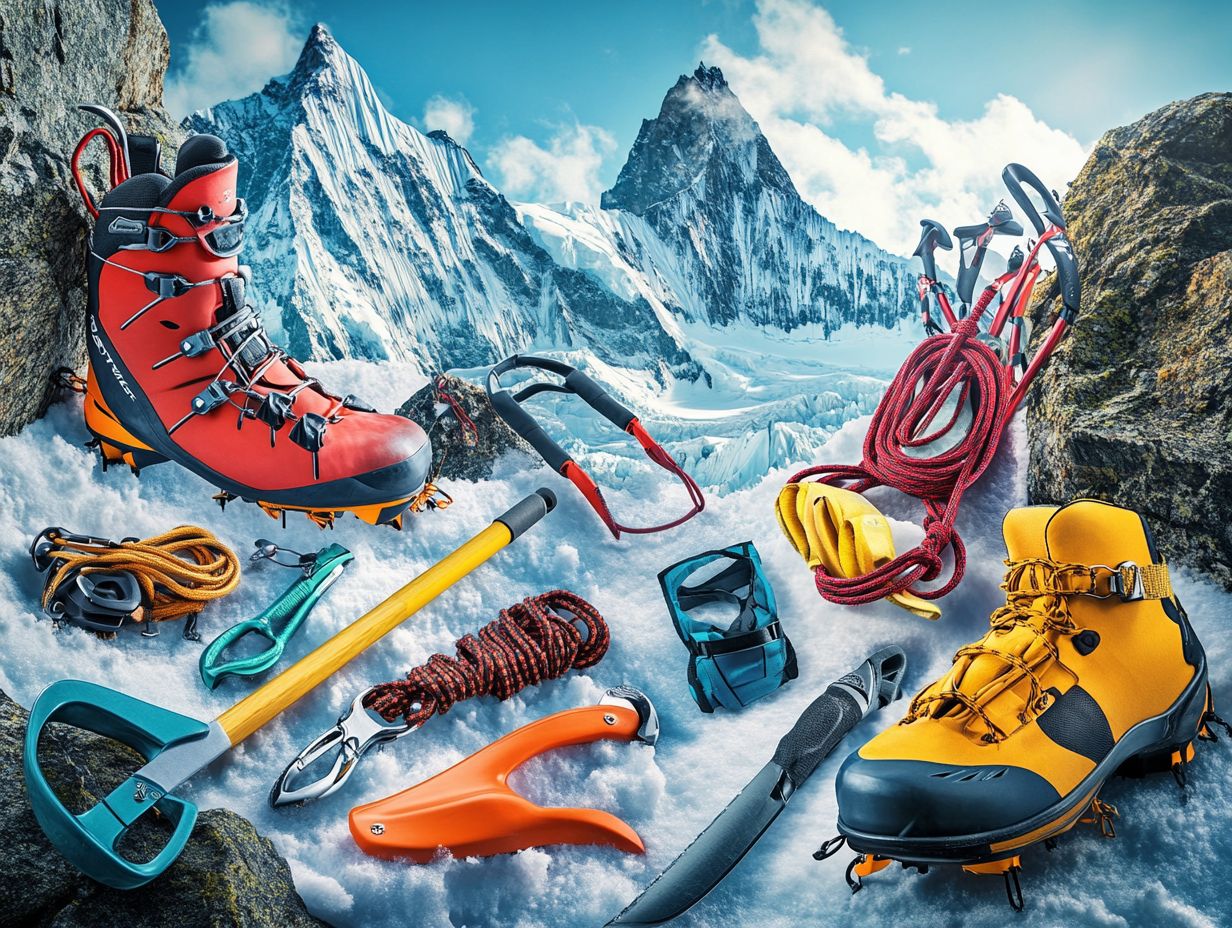
- Invest in high-quality, durable climbing boots with good grip for extreme conditions. Comfort and fit are key for a successful climb.
- Choose a harness with adjustable leg loops and a strong belay loop. Make sure to properly fit and adjust it to your body for safety, ensuring the best performance on every climb.
- Ropes are your lifeline, so invest in dynamic ropes ropes that stretch under load to absorb shock during a fall with a high weight capacity. Always check for wear and tear before each climb, particularly in cold-weather conditions.
1. Climbing Shoes
Climbing shoes are an important part of your climbing gear, playing a crucial role in enhancing your performance on the rugged terrain of Denali, especially as you prepare for the summit. Temperatures can plunge, and the weather may turn fierce, so you need shoes that prioritize comfort, warm insulation, and durability to meet the harsh challenges of the cold.
The right fit is paramount; it enables you to maintain sensitivity while navigating icy rock faces and steep inclines, ensuring you don t lose grip even on the most challenging terrains.
Insulation is vital in these frigid conditions, ensuring your feet remain warm without sacrificing mobility, especially when facing the biting wind and cold. Take the Scarpa Phantom 6000 and the 40 Below K2 Superlight, for instance; they embody these essential characteristics. For those planning an alpine adventure, consider checking out the best climbing gear for alpine climbs to enhance your experience.
Tailored specifically for high-altitude and cold-weather climbs, these shoes provide exceptional thermal protection, enabling you to tackle challenges like the Denali summit and other peaks with unwavering confidence.
With their robust grip, these shoes ensure secure footing on elusive and often slippery surfaces, showcasing how the right climbing shoes can be a transformative factor in achieving a successful ascent, especially on Denali.
2. Harness
A reliable climbing harness is essential for any expedition, particularly in challenging conditions like those on Denali, where teamwork and communication with your climbing partner are vital. It ensures your comfort and safety while allowing for best performance during your ascent, even in unpredictable weather.
You ll find various types of climbing harnesses available, each tailored with specific features to suit different climbing environments, whether it be for glacier travel or steep ascents. For instance, lightweight harnesses are ideal for alpine ascents, where every ounce matters, while full-body harnesses provide added security for situations needing rescue from deep cracks in the glacier.
Brands like Petzl and Black Diamond offer excellent options, such as the Petzl Sitta and Black Diamond Zone, which shine in extreme cold conditions thanks to their durability and comfort. For those seeking the best gear, check out the most durable climbing gear of 2024. These harnesses prioritize safety, often coming equipped with reinforced gear loops and exceptional padding, all while guaranteeing ease of movement, especially when wearing heavy gear. These are ideal for technical climbs and long multi-pitch routes.
Don’t wait! Equip yourself with the best gear to tackle the challenges ahead!
3. Ropes
Selecting the right climbing ropes is crucial for your safety and performance in Denali’s extreme cold. Durability and resistance to the cold are essential.
As you navigate the frigid terrain, consider both dynamic and static ropes. Dynamic ropes stretch to absorb the energy from falls, making them vital for lead climbing and safeguarding against sudden impacts.
Static ropes, on the other hand, are used in situations where falls aren t expected, like rappelling or hauling gear. It’s crucial to pick ropes that remain flexible in freezing temperatures, as stiff ropes can jeopardize your safety.
Always check the safety ratings and certifications on your ropes. This ensures they perform well in harsh environments and have been properly tested for durability.
4. Carabiners
Climbing carabiners are key components of your gear. They play a pivotal role in ensuring your safety and enhancing your performance in challenging environments like Denali.
There are two main types: locking and non-locking carabiners. Locking carabiners provide extra security, while non-locking ones allow for faster access in critical moments.
When choosing carabiners, consider weight and material. Lightweight aluminum options are ideal for cold weather, and certain designs improve grip, ensuring you can handle your gear effectively.
5. Crampons
Crampons are essential for traction on icy terrains, especially on the glaciers of Denali. Securing your footing is critical for safe climbing.
These specialized spikes attach to your climbing boots, providing stability and grip. They penetrate the ice s surface, ensuring safety in cold environments.
Choosing the right crampon is vital. They help you tackle specific challenges, from icy slopes to mixed terrains, enhancing your performance on the mountain.
6. Ice Axe
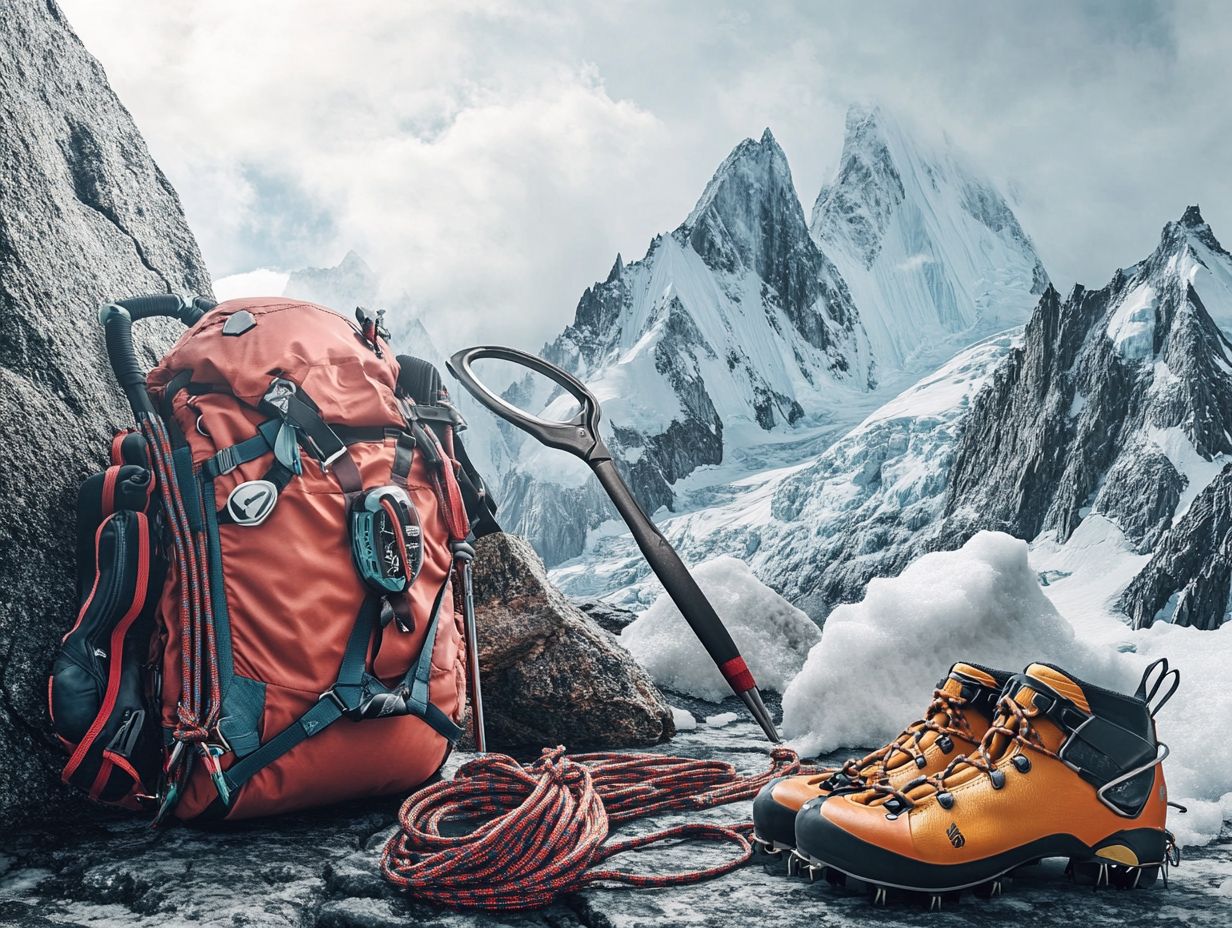
An ice axe is an essential tool in your climbing kit, especially when tackling the icy slopes of Denali. Cold weather can create challenging conditions, and its design and performance are critical for ensuring your safety and effectiveness. This allows you to focus on your climb without distraction.
You ll find various types of ice axes tailored to specific needs, depending on your climbing goals and the environment. Technical axes work best on steep ice, while classic axes are often the go-to for glacier traverses, providing versatility for various climbing challenges.
When it comes time to choose your ice axe, consider key factors like length, weight, and pick design. These elements directly affect your maneuverability and effectiveness in different climbing scenarios, particularly in harsh weather.
Look for features such as a robust grip and a spike at the bottom; these enhancements provide stability and control on treacherous terrain, which is essential for your safety. Axes made from lightweight materials reduce fatigue, allowing for longer climbs without discomfort.
Choosing the right gear boosts your chances of success on the mountain!
7. Helmet
A climbing helmet is an essential piece of safety gear that protects you from falling debris and impacts, particularly in precarious environments like Denali. Weather conditions can shift rapidly and create significant risks for your team.
Choosing the right helmet is not just about ticking a box for compliance; it profoundly influences your overall climbing experience. Look for a lightweight design that won t weigh you down during long ascents, while also ensuring adequate ventilation to keep you cool during strenuous activities.
These features enable you to concentrate on your technique without being sidetracked by discomfort or fatigue. A well-fitted helmet boosts your confidence, allowing you to push your limits while knowing you have a reliable shield against unexpected hazards.
Don t underestimate the importance of good helmets; they enhance both safety and comfort on even the most challenging routes.
8. Climbing Gloves
Quality climbing gloves allow you to maintain dexterity and grip while keeping warm during cold-weather ascents, especially when facing the icy challenges of Denali.
When you re up against extreme temperatures, selecting gloves with robust insulation like those crafted from Primaloft (a type of synthetic insulation) or Down can significantly elevate your comfort and performance. Consider the Mammut Extreme Mitten; it provides outstanding warmth without compromising your ability to move.
Then there are Black Diamond’s Mercury Mitts, featuring a removable liner for versatility during unpredictable temperature swings. When grip is crucial, the Scarpa Drago gloves come equipped with a sticky rubber coating to enhance traction while ensuring quick, precise finger movements.
This perfect blend of insulation, grip, and dexterity ensures you re fully equipped for any alpine adventure that comes your way. Be ready for any challenge that comes your way!
9. Belay Device
A reliable belay device is essential for your safety while climbing. This is especially true on challenging ascents, like Denali, where temperature fluctuations can affect gear performance.
Understanding types of belay devices like tubular, assisted-braking, and figure-eight is vital. Each type operates differently, enhancing your security during a fall.
Selecting the right device for your climbing conditions can make a significant difference. For instance, assisted-braking devices offer extra protection, which is particularly beneficial for newer climbers.
By making an informed choice, you can boost both your safety and performance on the ascent.
10. Quickdraws
Quickdraws are key hardware for climbing. They create efficient connections between the rope and anchor, ensuring safety in unpredictable conditions.
Understanding the different types of quickdraws can greatly impact your climbing safety. Typically, they consist of two carabiners linked by a robust sling.
If you’re a sport climber, lightweight quickdraws may enhance your speed. In contrast, trad climbers often prefer sturdier versions for rugged conditions.
When selecting quickdraws, consider:
- Gate strength
- Keylock designs to prevent snagging
- Sling length that fits your routes
A good quickdraw not only enhances your safety but also boosts climbing efficiency, letting you focus more on technique.
11. Chalk Bag
A chalk bag is a small but essential tool for any climber. It enhances grip and performance, especially in humid or sweaty conditions.
This compact accessory combats slippery holds, boosting your safety and confidence on steep ascents.
You have a wide selection of chalk bags, each crafted in various sizes and styles. Some feature a closure system while others offer quick-access designs for those intense moments.
These bags often showcase unique designs and vibrant colors that match your style. This mix of aesthetics and utility makes climbing more enjoyable.
12. Climbing Pack
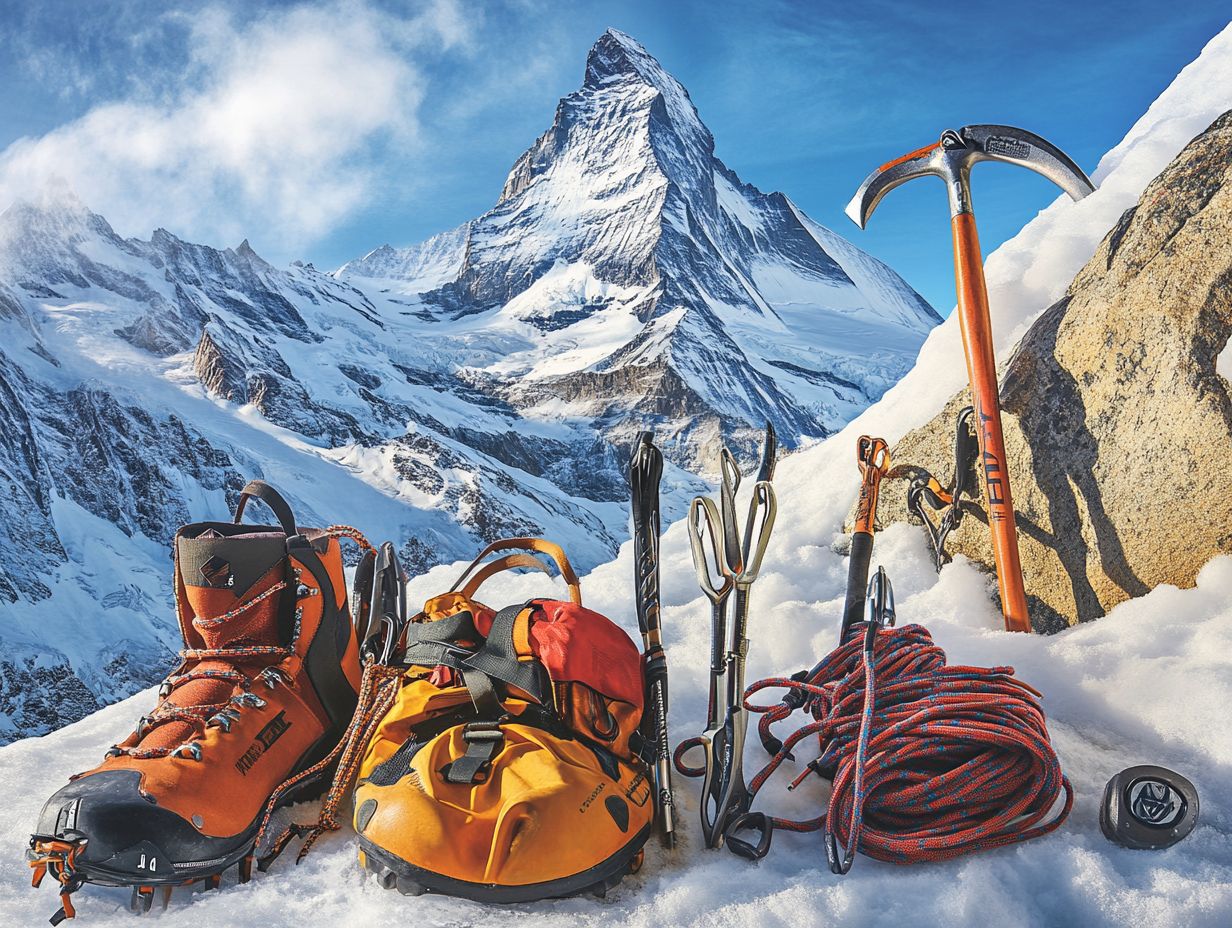
A well-designed climbing pack is crucial for storing your gear. On demanding expeditions like Denali, comfort and performance greatly influence your experience.
These packs come in various styles for different needs, whether for a day trip or a multi-day adventure. Many feature compartments to keep your tools and safety equipment organized.
Innovations like adjustable harness systems and breathable back panels enhance comfort. This ensures the pack sits securely without restricting your movement.
Choosing the right climbing pack streamlines gear access and boosts morale during challenges. It makes your adventure more enjoyable, no matter the weather conditions or rugged terrains you face.
13. Headlamp
A dependable headlamp is an invaluable asset in your climbing gear. It offers visibility and safety during those early morning or late evening ascents, particularly in the rugged terrain of Denali. Here, cold weather can pose visibility challenges.
When selecting a good headlamp, remember that its qualities extend beyond just brightness. You must consider battery life to ensure reliable performance throughout your extended trips. A dimming light in the middle of a climb can jeopardize your safety, making a long-lasting battery essential.
Weather resistance is equally important. The unpredictable elements of mountain environments can quickly render inferior gear ineffective. By prioritizing these features, you’ll enhance your ability to navigate tricky paths and respond effectively when visibility is limited. Additionally, having the right essential climbing gear for sport climbers will always keep safety at the forefront of your adventures.
14. First Aid Kit
A well-stocked first aid kit is essential when facing formidable ascents like Denali. Unpredictable weather and challenging conditions can turn a routine climb into an emergency.
Having the right supplies at your fingertips gives you peace of mind and significantly boosts your ability to respond effectively to various injuries. Key items you should consider including are:
- Adhesive bandages for minor cuts that seem to pop up out of nowhere.
- Antiseptic wipes to keep infections at bay.
- Gauze and medical tape for more serious wounds that need extra care.
- Pain relievers to help manage any discomfort along the way.
Don t overlook the importance of including supplies for specific climbing incidents. Think about splints for fractures and thermal blankets to combat hypothermia. Being prepared in such remote environments can make all the difference in emergencies.
Effective navigation tools are essential for your climbing adventures. On the intricate terrains of Denali, precise Global Positioning System (GPS) and maps can mean the difference between a safe journey and a perilous situation.
You must be well-versed in both modern technology and traditional navigation methods to tackle challenges posed by unpredictable weather and rugged topography.
GPS devices, often loaded with maps and features like altitude readings, provide crucial real-time data. They enable you to track your progress and pinpoint your location. However, relying solely on technology can be risky; battery failures or loss of signal can leave you exposed.
This is where traditional maps come into play. They offer a reliable backup to guide you through challenging routes. Familiarizing yourself with both tools enhances your preparation and fosters a deeper understanding of the landscape, ultimately ensuring a safer and more successful climb.
How to Choose the Right Climbing Gear for Extreme Conditions?
Choosing the right climbing gear for extreme conditions is a vital decision that can significantly impact your safety and performance on lofty climbs. In unforgiving environments like Denali, the weather can shift from serene to savage in an instant.
As you select your gear, take the time to evaluate several key factors, including insulation properties and waterproof capabilities. This ensures you are primed for optimal performance in harsh climates. Prioritize safety features such as durable harnesses, robust carabiners, and reliable helmets; they are essential for preventing accidents and keeping you secure. Additionally, consider checking out the top climbing gear for rock climbers to enhance your selection.
Understanding the specific demands of the terrain is crucial. Whether you need technical ice tools or crampons for icy surfaces, these considerations will shape your gear choices.
For those preparing for daring ascents, investing in quality items like high-visibility jackets, versatile backpacks, and advanced navigation tools can profoundly enhance both your safety and overall climbing experience.
Frequently Asked Questions
What are the essential items for extreme climbing conditions?

For extreme climbing, you’ll need essential gear like a harness, ropes, carabiners, helmets, ice axes, crampons, and protective clothing.
Which brand offers the best climbing gear for extreme conditions?
Top brands for extreme climbing gear include Black Diamond, Petzl, and Mammut. They are known for their quality and reliability.
What type of ropes should I use for extreme climbing?
Use dynamic ropes for extreme climbing. They stretch to absorb the shock of a fall, making them essential for safety.
Do I need specialized clothing for extreme climbing?
Yes, specialized clothing is crucial for extreme climbing. Look for waterproof jackets, insulated pants, and warm gloves to stay safe in harsh weather.
What should I look for in a climbing helmet for extreme conditions?
Choose a lightweight and durable climbing helmet. It should also provide good ventilation and fit comfortably over a beanie or headlamp.
Are there any specific features to consider when choosing ice axes for extreme conditions?
Select a quality ice axe with a comfortable grip and lightweight design. A sharp head is crucial for effective ice penetration and safety.
Get your gear ready and embrace the thrill of extreme climbing!

